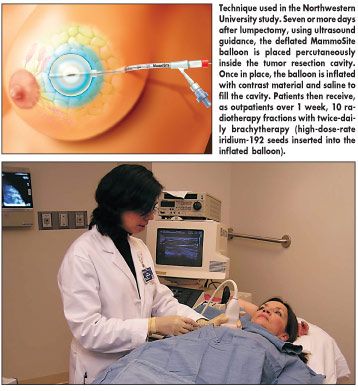Brachytherapy Balloon Can Be Placed After Final Pathology
Ultrasound-guided placement of a balloon catheter for partial breast brachytherapy can be safely delayed until after the final pathology report has confirmed that the patient is a candidate for the procedure, according to a new study.
CHICAGOUltrasound-guided placement of a balloon catheter for partial breast brachytherapy can be safely delayed until after the final pathology report has confirmed that the patient is a candidate for the procedure, according to a new study. Ellen Mendelson, MD, director of breast imaging, Feinberg School of Medicine, Northwestern University, presented the results at the 92nd Annual Meeting of the Radiological Society of North America (RSNA) (abstract SSM01-05).
The retrospective study included 35 women who underwent ultrasound-guided partial breast brachytherapy between 2002 and 2006 (see figures). The researchers showed that placement of the MammoSite balloon catheter could be done from 7 to 47 days after lumpectomy. Ultrasound-guided partial breast brachytherapy also markedly reduced the time required for postoperative radiation therapy. Partial breast brachytherapy was completed in 5 to 7 days, 5 weeks less than the conventional course of whole breast radiation therapy.
Although whole breast irradiation is the current standard of care for delivering radiotherapy to the lumpectomy site, partial breast irradiation (PBI) directed to the lumpectomy cavity is proving to be equally effective. Rates of breast cancer recurrence in other studies have been similar for whole and partial breast irradiation (from less than 2% up to 6%), Dr. Mendelson said.
PBI May Be Preferable
Partial breast irradiation may be preferable, she commented, because of its concentrated focus. By directing radiation only to the portion of the breast that surrounds the lumpectomy site, the procedure reduces the chance of adversely affecting healthy tissue in other parts of the breast.
Balloon catheters to deliver partial breast brachytherapy typically are placed during lumpectomy surgery, but pathological findings, which may not be finalized until 2 days after surgery, may show that the patient does not meet the criteria for partial breast irradiation.

"Our research shows that immediate placement of the balloon catheter is unnecessary and may add to the cost," said Lora D. Barke, DO, assistant professor, Feinberg School of Medicine, Northwestern University. "Radiologists can wait until receiving the final pathology, and then safely and efficiently insert the catheter with ultrasound guidance immediately before the patient begins brachytherapy. This allows time to determine if brachytherapy is appropriate for the patient, and allows the patient and physician to consider and weigh the benefits of various treatment options."
Drs. Mendelson and Barke and their colleagues have been performing ultrasound to guide the placement of balloon catheters for partial breast brachytherapy for 4 years. Patients are candidates for partial breast brachytherapy if their tumors are less than 2.5 cm, the surgical lumpectomy margins are pathologically negative, and there is no evidence of extensive lymphovascular invasion or lymph node involvement. The procedure also requires adequate skin-to-seroma thickness (at last 6 mm) and adequate seroma size to cover the balloon.
Of 75 patients who were considered to be eligible for partial breast irradiation in this study, 44 (59%) met all pathological criteria. Nine of these patients refused to undergo partial breast irradiation, leaving a total study population of 35.
Long-Term Results
Although follow-up has not been long enough to make any conclusions about the effect of partial breast brachytherapy on disease recurrence, in the short term there has been only one recurrence of cancer in the study, she said.
Dr. Mendelson noted that a large multicenter trial conducted by the National Surgical Adjuvant Breast and Bowel Project (NSABP-039) is accruing patients to assess the long-term results of partial breast irradiation. The study is evaluating different forms of partial breast irradiation, including balloon catheter brachytherapy, she added.